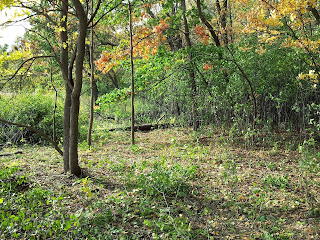Post contributed by Meredith from Conservation Corps Youth Outdoors Crew 1:
 This week, two of the Conservation Corps, young adult crews have been enjoying some crisp and sunny fall days working at Highwood Nature Preserve located in south east Saint Paul. Highwood is a unique addition to the city’s outdoor recreation opportunities and is a favorite place of many of the crew members. Perched on a bluff overlooking the Mississippi River and Twin Cities skylines, Highwood is home to a unique remnant prairie. This beautiful pocket of prairie serves as a reminder of what the southwestern third of the state looked like before European settlement.
This week, two of the Conservation Corps, young adult crews have been enjoying some crisp and sunny fall days working at Highwood Nature Preserve located in south east Saint Paul. Highwood is a unique addition to the city’s outdoor recreation opportunities and is a favorite place of many of the crew members. Perched on a bluff overlooking the Mississippi River and Twin Cities skylines, Highwood is home to a unique remnant prairie. This beautiful pocket of prairie serves as a reminder of what the southwestern third of the state looked like before European settlement. |
| On the job at Highwood. |
Grasslands and other prairie ecosystems like the one found at Highwood are highly threatened both in Minnesota and worldwide. In Minnesota nearly 18 million acres of prairie covered the state prior to European settlement. Today, less that one percent of Minnesota's native prairies remain. Prairie ecosystems have nutrient rich soil and fertile grasses that were readily plowed under and converted to agricultural use by European settlers in the mid-1800s. Today fire suppression, invasive species, energy development and conversion to other land use threatens our remaining prairies.
 |
| They sure enjoy what they do! |
For information on what actions are being taken in the state to preserve these ecosystems please visit the Nature Conservancy and the Northern Tallgrass Prairie project websites.
For information on Prairie conservation on your own land please see the Minnesota Department of Natural Resources' publication "Going Native, A prairie restoration handbook for Minnesota landowners".

